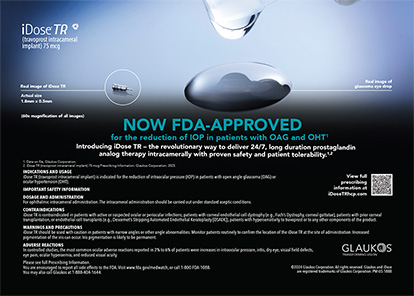It is no secret that today’s cataract surgical patients have high expectations, whether they will receive new-technology IOLs or monofocal implants. Because patients know that cataract surgery is associated with excellent postoperative visual acuity, it is important for eye care specialists to be thorough in terms of the preoperative evaluation of all patients. It must include a comprehensive determination of the patient’s ocular health and appropriate strategies to treat any existing corneal disease.
Clinicians should consider four areas during the preoperative phase: (1) the ocular surface (ie, dry eye syndrome, miebomian gland dysfunction, and/or blepharitis), (2) the corneal surface (ie, epithelial basement membrane dystrophy and anterior stromal scars in the visual axis), (3) topography, and (4) optical coherence tomography of the macula.
OCULAR SURFACE
Dry eye disease and blepharitis are common among patients scheduled for cataract surgery, although many are asymptomatic. A failure to identify and treat patients with significant ocular disease can adversely affect the outcome of cataract surgery.
To determine the frequency of dry eye in individuals scheduled to undergo cataract surgery, my colleagues and I conducted a nine-site study.1 Patients included in this investigation were aged 55 years and older, with a mean age of 71. The preliminary results of 102 patients (204 eyes) revealed an average tear breakup time (TBUT) of 4.93 seconds. In addition, we found that
• 126 (61.7%) eyes had TBUTs of 5 seconds or less
• 169 (82.8%) eyes had TBUTs of 7 seconds or less
• 92 eyes (45.1%) had central corneal staining
• 95 eyes (46.0%) had a Schirmer score of 10 or less
We concluded that dry eye is very common among patients scheduled for cataract surgery. Preoperative testing for planning the IOL’s power requires a healthy tear film to be accurate. Untreated corneal surface disease can negatively affect keratometry and thereby skew IOL calculations.
In another study, my colleagues and I looked at the prevalence of blepharitis in patients scheduled for cataract surgery.2 The mean age of included patients was 72 years, and 100 patients were evaluated. We found that 59% of patients had blepharitis, and more than 85% of the eyes had an average TBUT of 9 seconds or less.
Based on our results, a large number of people scheduled for cataract surgery have abnormal TBUTs and central corneal staining. We determined that patients should be evaluated and treatment should be initiated for aqueous-deficient dry eye and/or blepharitis, if present.
ADDITIONAL EVALUATION
Corneal Surface
Physicians should examine the cornea to identify epithelial basement membrane dystrophy or small anterior scars in the visual axis. These findings can negatively affect the patient’s postoperative quality of vision and success with premium IOLs.
Topography
Eye care practitioners must perform preoperative corneal topography to determine a patient’s candidacy for presbyopiacorrecting IOLs. Topography can help rule out forme fruste keratoconus, keratoconus, pellucid marginal degeneration, and irregular astigmatism. It is also important to the evaluation of dry spots, which require treatment. If the patient has had prior LASIK or RK, clinicians should ensure that he or she has a large central optical zone. Topography can establish the patient’s eligibility for corneal refractive surgery in case he or she needs a refractive enhancement after the cataract procedure.
Macular Examination
A preoperative optical coherence tomography scan of the macula assesses the health of the posterior segment prior to cataract surgery. This examination should be used to rule out epiretinal membranes (which increase the risk of cystoid macular edema), vitreomacular traction syndrome, and early macular holes.
CONCLUSION
Preoperative steps to evaluate and treat patients before they receive traditional monofocal IOLs optimize visual outcomes. In addition, a comprehensive evaluation and therapeutic plan help to identify proper candidates for presbyopia-correcting IOLs. Following these guidelines and identifying the conditions mentioned will foster a higher success rate with premium lenses and identify patients who may undergo a refractive enhancement if needed.
This discussion was adapted with permission from an article in Advanced Ocular Care’s November/December 2010 issue.
William B. Trattler, MD, is the director of cornea at the Center for Excellence in Eye Care in Miami and is a chief medical editor of Cataract & Refractive Surgery Today’s sister publication, Advanced Ocular Care. He is a consultant to or receives research funding/speaking honoraria from Abbott Medical Optics Inc.; Alcon Laboratories, Inc.; Allergan, Inc.; Inspire Pharmaceuticals; and Ista Pharmaceuticals, Inc. Dr. Trattler may be reached at (305) 598-2020; wtrattler@earthlink.net.
- Trattler W,Goldberg D,Reilly C.Incidence of concomitant cataract and dry eye:prospective health assessment of cataract patients.Presented at:World Cornea Congress;April 8,2010;Boston,MA.
- Luchs J,Buznego C,Trattler W.Prevalence of blepharitis in patients scheduled for routine cataract surgery.Poster presented at:ASCRS Symposium on Cataract,IOL and Refractive Surgery;April 11,2010;Boston,MA.


